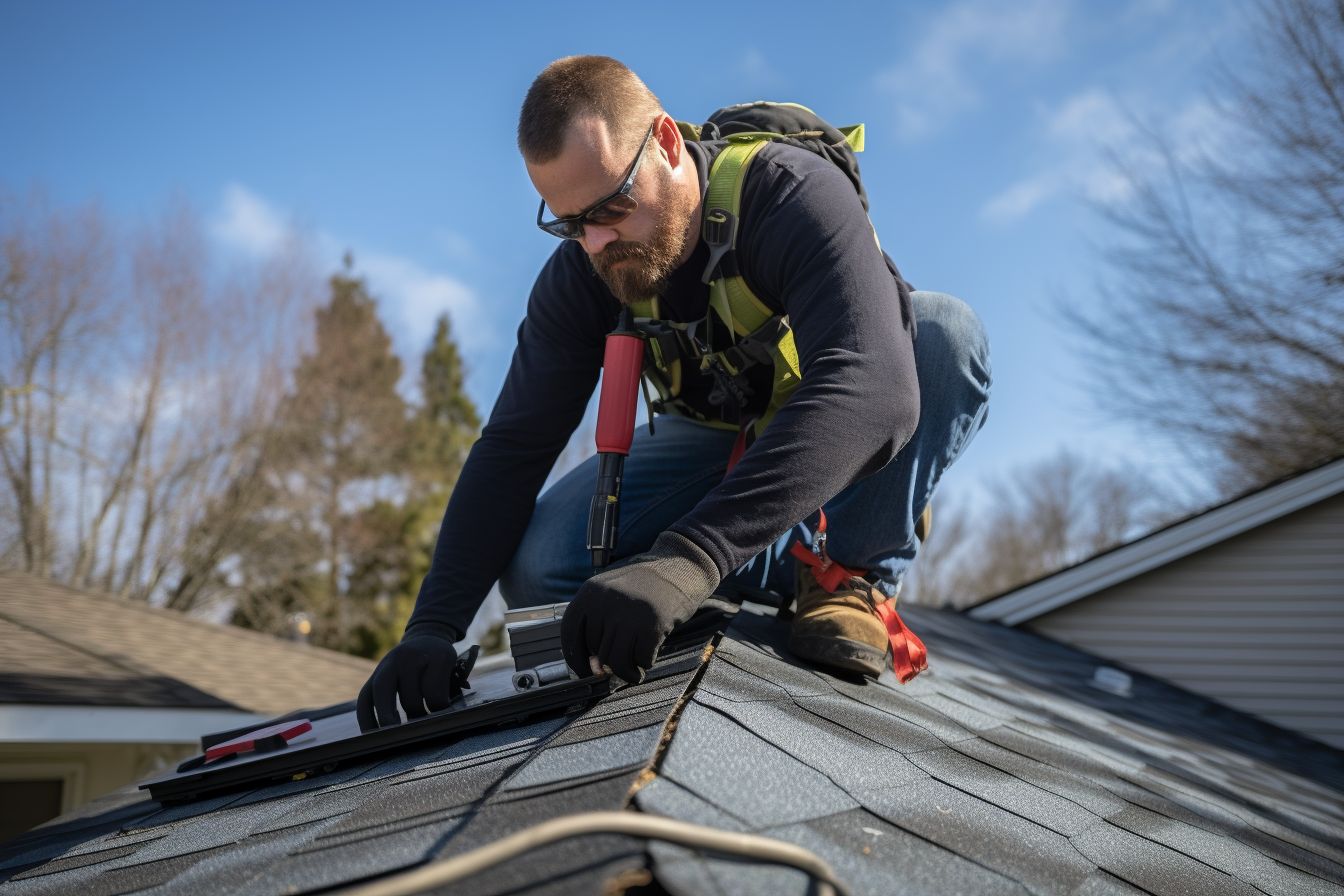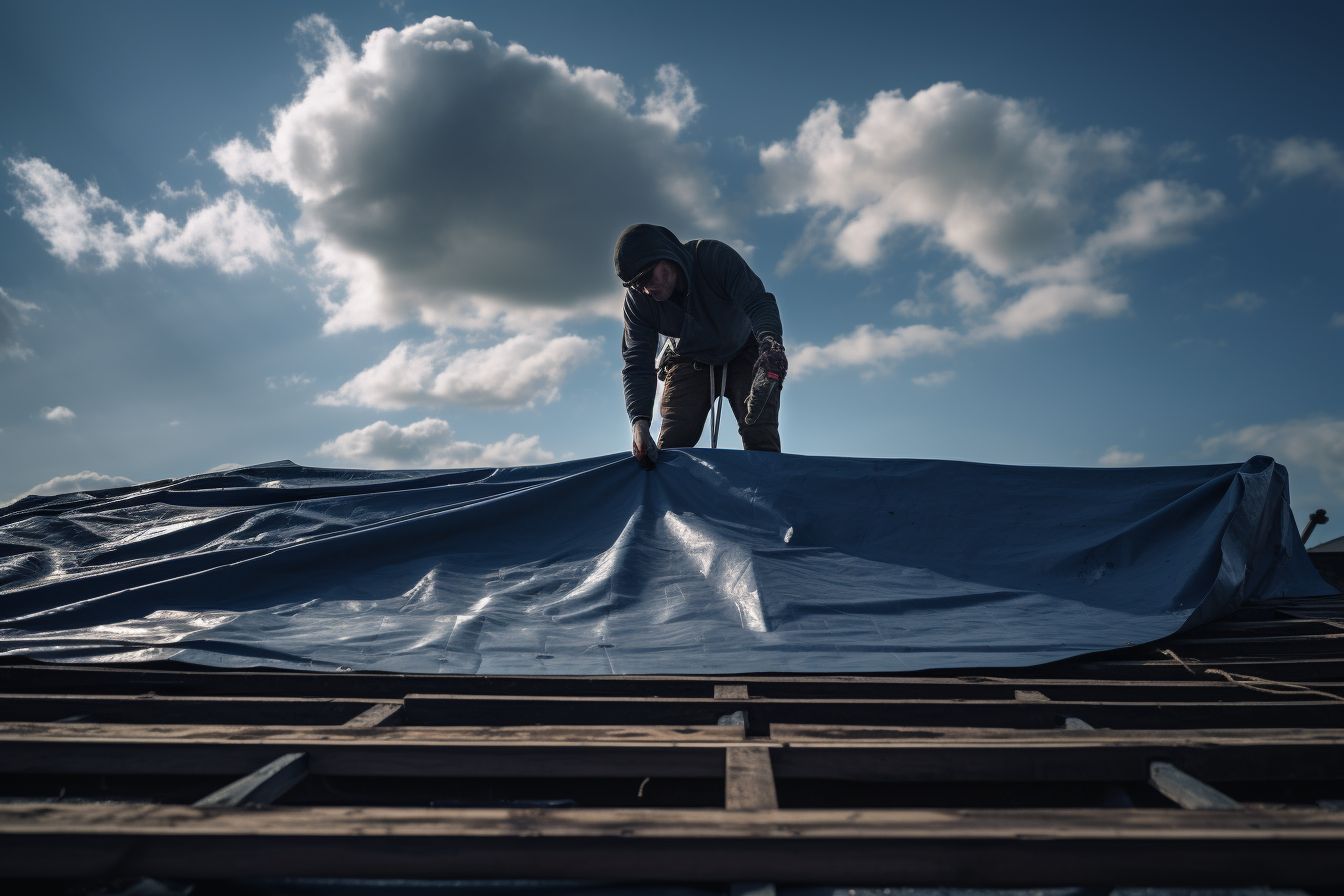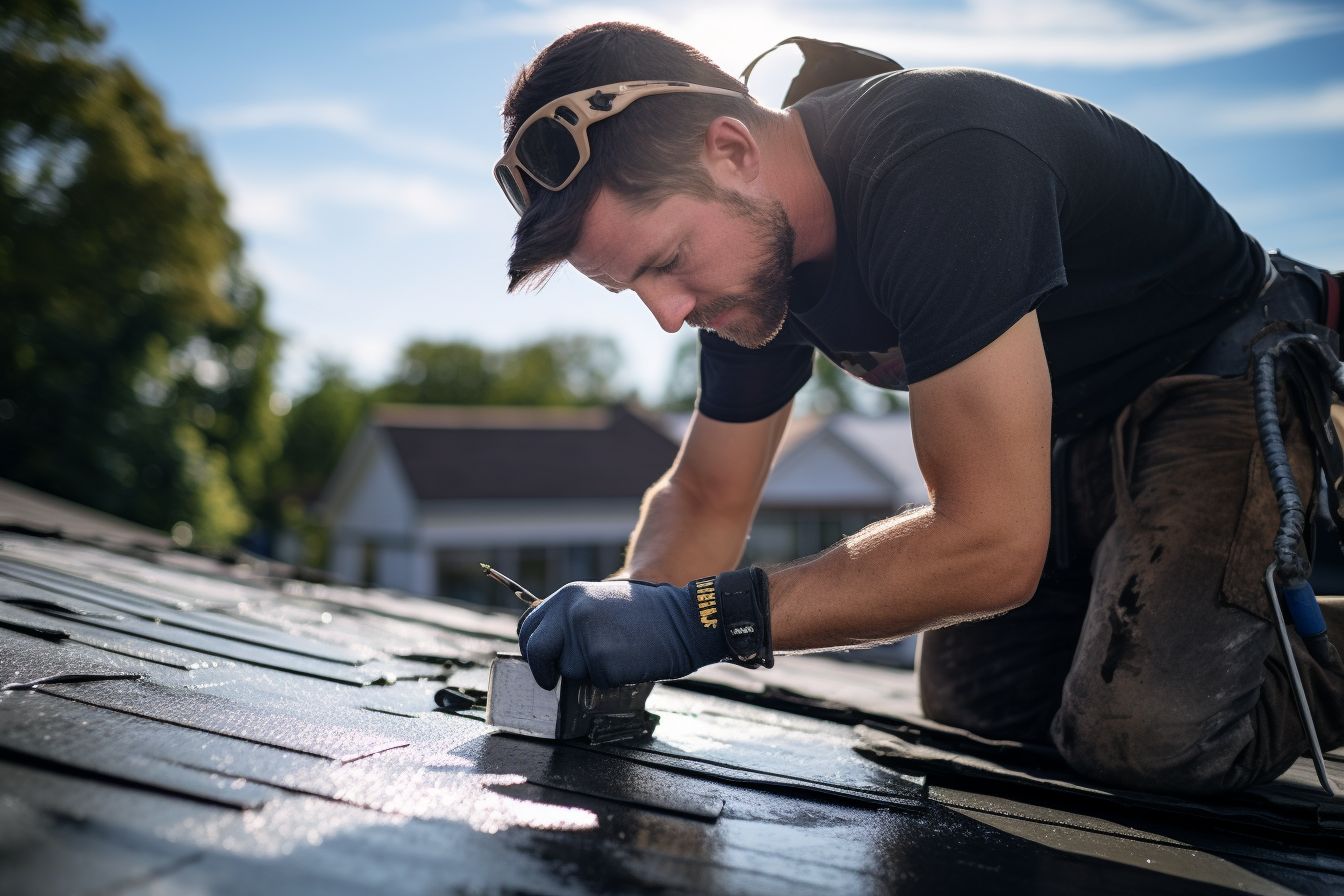Have you noticed a small roof leak? Did you know even minor leaks can lead to major damage over time if left untreated? This blog post offers practical tips on locating and repairing these often-inconspicuous water intrusions.
Intrigued? Read on for simple solutions that could save your home!
Key Takeaways
- Use a garden hose to locate the source of small roof leaks by spraying water on different sections.
- To indicate roof leaks, look for water stains and discolouration on ceilings and walls.
- Patch small leaks with roofing cement or silicone caulk as temporary solutions until proper repairs can be made.
- Temporary fixes like tar paper, plastic sheets, and waterproof tarps can temporarily relieve small roof leaks.
How to Find Small Roof Leaks
To find small roof leaks, use a garden hose to pinpoint the source or look for water stains and discoloration on ceilings and walls.
Use a garden hose to find the source of the leak.
Locating the source of a small roof leak can be made easier with the help of a simple garden hose. First, thoroughly examine your ceiling and walls for water stains, discoloration, and tell-tale signs of a leak. Then, begin on your roof, spraying water on different sections with the garden hose.
- Schedule a dry, sunny day for your leak detection exercise.
- Invite a partner to stay inside the house, particularly in the attic area, to pinpoint any water intrusion while you’re on the roof.
- Start hosing down one roof area at a time, starting from the lowest point and moving upwards.
- Allow water to run over each section for several minutes before moving to another section.
- Maintain communication with your partner inside to report if and when they spot any leaks.
Look for water stains and discoloration on ceilings and walls
Identifying small roof leaks often begins by looking for water stains and discoloration on ceilings and walls.
- Start your investigation in areas where water damage is most likely to appear.
- Observe the ceiling under your roof for any signs of staining or discoloration.
- Be aware of any unusual moisture seepage along your home’s walls.
- Keep an eye out for dried and discoloured deposits, indicators of evaporated liquid that have seeped into your ceiling.
- Notice the rotten wood or discoloured felt paper around the leak area in your roof.
- Don’t ignore drooping ceilings; they might be signalling a leaky roof.
- Pay attention to missing materials from your roof, as it is a common sign of leaking.
- Mould stains on ceilings can indicate a high humidity problem, lack of ventilation, or even a persistent roof leak.
Quick Fix Solutions for Small Roof Leaks

Patch the leak with roofing cement or silicone caulk to stop water from entering your home.
Patch the leak with roofing cement or silicone caulk
Roof leaks, even small ones, can cause significant damage over time. Quickly addressing these leaks can help you avoid more serious problems in the future.
- Roofing cement is a popular choice for patching small roof leaks. It has a thick texture and hardens quickly, forming a waterproof seal over the hole.
- Silicone caulk is another great option for repairing small leaks. It dries clear and remains flexible, allowing it to withstand weather changes without cracking or peeling.
- Both roofing cement and silicone caulk are effective on different roofing materials, ranging from shingles to metal flashing.
- The patching process involves spreading the roofing cement or silicone caulk over the problem area with a putty knife and smoothing it down to ensure even coverage.
- Repairing tiny holes in shingles, soffits, or flashing is possible using silicone or caulking.
- Despite its efficiency, using a sealant like caulk or roof cement does not count as a long-term solution for fixing a leaky roof.
Use tar paper and plastic roofing cement as a temporary fix
Tar paper and plastic roofing cement can be used as a temporary fix for small roof leaks. Spread the roofing cement or tar paper on the leaking area with a caulk gun or putty knife.
How to Temporarily Fix a Roof Leak
To temporarily fix a roof leak, there are a few solutions you can try. One option is roofing cement or silicone caulk to patch the leak. Simply apply either of these sealants directly onto the area where the leak occurs.
Another temporary fix involves using tar paper and plastic roofing cement. Cut a piece of tar paper to cover the leaking area, then apply plastic roofing cement to add waterproofing.
Additionally, if you’re dealing with loose shingles causing the leak, you can smooth them back down or shift them into place as a temporary solution. It’s important to note that while these fixes may provide some relief from leaks in the short term, they are not permanent solutions and will eventually need proper repairs.
Nonetheless, they can be effective in emergencies until professional help is available. By implementing these temporary measures, you can prevent further damage and minimize potential water infiltration until more extensive repairs can be made.
Temporary Fixes That Will Eventually Need Real Repairs

Polyethylene plastic sheets, waterproof tarps, tar paper, and patching or plugging the leak are all temporary fixes for small roof leaks that will eventually require proper repairs.
Polyethylene plastic sheets
Polyethylene plastic sheets can be handy for temporarily fixing small roof leaks. These sheets can be fastened to the roof using roofing nails, providing a quick and easy solution to stop water from entering your home.
You can weigh down the plastic sheets with large rocks or bricks to ensure added stability. Although they are considered less reliable than waterproof tarps, polyethylene plastic sheets can serve as a temporary patch until a proper repair can be made.
Waterproof tarps
Waterproof tarps are commonly used as temporary fixes for small roof leaks. These tarps are reliable solutions to prevent water from entering the home and causing further damage. In emergencies, tarping a leaking roof can effectively stop water infiltration until professional roofers can conduct proper inspections and repairs.
By securely securing temporary roof tarps, additional leaks or damage can be prevented while waiting for the necessary repairs to be done. Waterproof tarps safeguard against small roof damage, protecting homes from water infiltration.
Tar paper
Tar paper is a commonly used temporary solution to prevent roof leaks. It is an effective barrier, stopping water from infiltrating the roof and causing further damage. Homeowners can use tar paper and plastic roofing cement to patch up small leaks without professional assistance.
However, it’s important to note that tar paper is not a long-term fix for roof leaks. Eventually, it will require real repairs to address the underlying issues causing the leak. Despite its temporary nature, tar paper provides a quick and convenient way for DIY homeowners to temporarily remedy roof leaks and protect their homes from water damage.
Patching or plugging the leak
Patching or plugging the leak is a temporary solution for small roof leaks that will eventually require real repairs. To patch a leak, you can use roofing cement or silicone caulk to seal the damaged area.
Plugging, on the other hand, involves using water and a powder similar to roofing cement to fill the leak temporarily. These methods are commonly used to manage attic leaks or small roof leaks until professional help can be obtained.
While they offer a quick fix, it’s important to remember that these solutions are not permanent and should only be used temporarily until proper repairs can be made.
Conclusion

In conclusion, “Quick Fixes for Small Roof Leaks” provides practical solutions for DIY roof repair, empowering homeowners to address common leaks without professional assistance. Individuals can patch small roof leaks effectively by identifying the source of the leak and using simple materials like roofing cement or silicone caulk.
Remember to act quickly to minimize interior damage and consider seeking professional help for larger holes or structural issues. Take charge of your roof’s maintenance and save time and money by addressing small leaks promptly.
FAQs
1. How can I identify a small roof leak?
You can identify a small roof leak by noticing water stains on the ceiling, dampness or discolouration on the walls, or dripping water during rainfall.
2. Can I fix a small roof leak myself?
Yes, you can fix a small roof leak using materials like roofing cement or sealant to patch up the affected area.
3. What tools do I need to fix a small roof leak?
To fix a small roof leak, you may need basic tools such as a ladder, roofing cement or sealant, a caulk gun, a putty knife, and gloves for protection.
4. Are there any temporary solutions for stopping a small roof leak?
Yes, there are temporary solutions for stopping a small roof leak, such as placing buckets under the leaking area to catch the water or using tarps to cover the affected section until repairs can be made.
5. When should I seek professional help for fixing my roof leaks?
You should seek professional help to fix your roof leaks if the damage is extensive or if you’re unsure how to repair it safely. A professional roofer will have the expertise and equipment to address more complex issues and ensure long-lasting repairs.

